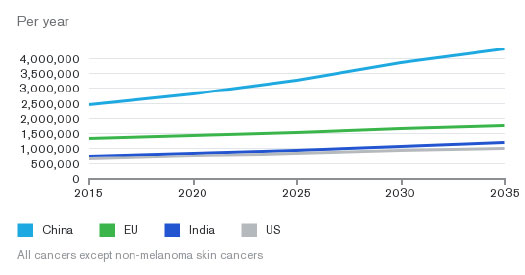Lung Cancer Problem
Non-Small Cell Lung Cancer Therapeutics Market
Non-small cell lung cancer (NSCLC) is the one of the commonest form of lung cancers – accounting for 85% of all lung cancer cases. It is the most feared because it metastasizes into the bones and other tissues, making it tough to diagnose and treat it. Drugs meant to treat such a type of cancer range from regular regimens to targeted therapies. They are formulated leveraging simple chemistries to advanced complex proteins.
The global market for non-small cell lung cancer therapeutics has seen robust growth due to: increasing public awareness; favorable government initiatives; rapid approvals for drugs for non-small cell lung cancer by regulatory bodies; and generous monetary assistance for research. Despite the efficacy of targeted therapies and the uncovering of numerous molecular targets, the development of most drugs is in an early-stage pipeline. A major cause of worry in the non-small cell lung cancer therapeutics market is the resistance to targeted therapies.
Current Situation
Conventional anti-cancer therapies are costly, do not always provide positive outcomes or reduce cancer death, and are unable to improve patient compliance during treatment.
Market Size of Non-Small Cell Lung Cancer
The global non-small cell lung cancer therapeutics market:
- Was US$4.9 bn in 2014
- Expanding at 12.1% (CAGR) from 2015 to 2023
- Slated to grow to US$15.1 bn in 2023
The global non-small cell lung cancer therapeutics market is fragmented with robust competition among both generic and branded companies. The most prominent names in this market are: Bristol-Myers Squibb, Eli Lilly and Company, Boehringer Ingelheim, Pfizer, Inc., AstraZeneca plc, and Novartis AG.
United States and Europe
- The Non-Small-Cell Lung Cancer (NSCLC) drug market in the United States, France, Germany, Italy, Spain, United Kingdom and Japan is growing from USD 4.3 Billion in 2009 to USD 6.9 Billion in 2019. The CAGR market is growing 4.84% from 2009 to 2019
India
- The non-small-cell lung cancer drug market grew from USD 27.7 Billion in 2008 to USD 52.1 Billion in 2013. This growth was fueled by an increased uptake of antimetabolites and targeted therapies.
- The epidermal growth factor receptor (EGFR) and vascular endothelial growth factor (VEGF) inhibitor drug classes have dominated the market through-out the this period with a combined market share of 55 percent through to 2013.
- The Indian non-small-cell lung cancer drug market CAGR growth was 13.47% from 2008 to 2015.
Asia Pacific Marketing Propelled by Burgeoning Population
The global market for non-small cell lung cancer therapeutics includes five key regions: North America, Europe, India, Asia Pacific, and the Rest of the World. Among them, North America leads with the maximum share of market due to the presence of a large healthcare infrastructure and strong research support by the U.S. Federal Government. In terms of growth rate, Asia Pacific is predicted to grow more rapidly that all other regions due to a burgeoning population, increasing awareness and the number of government projects dealing with lung cancer, as well as ongoing efforts for timely intervention.


